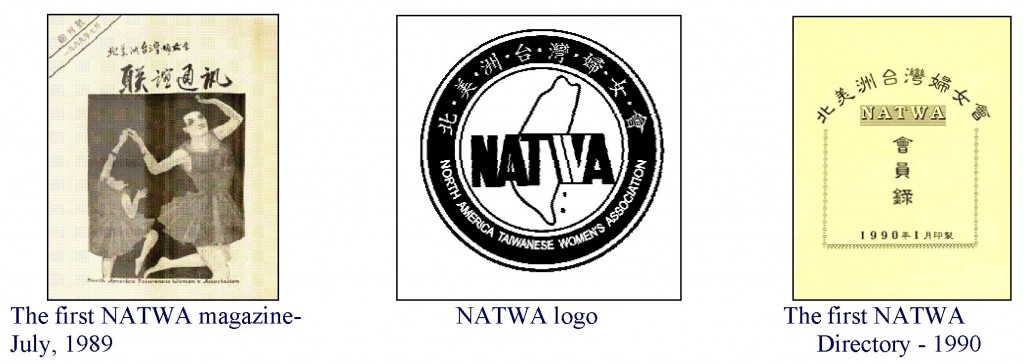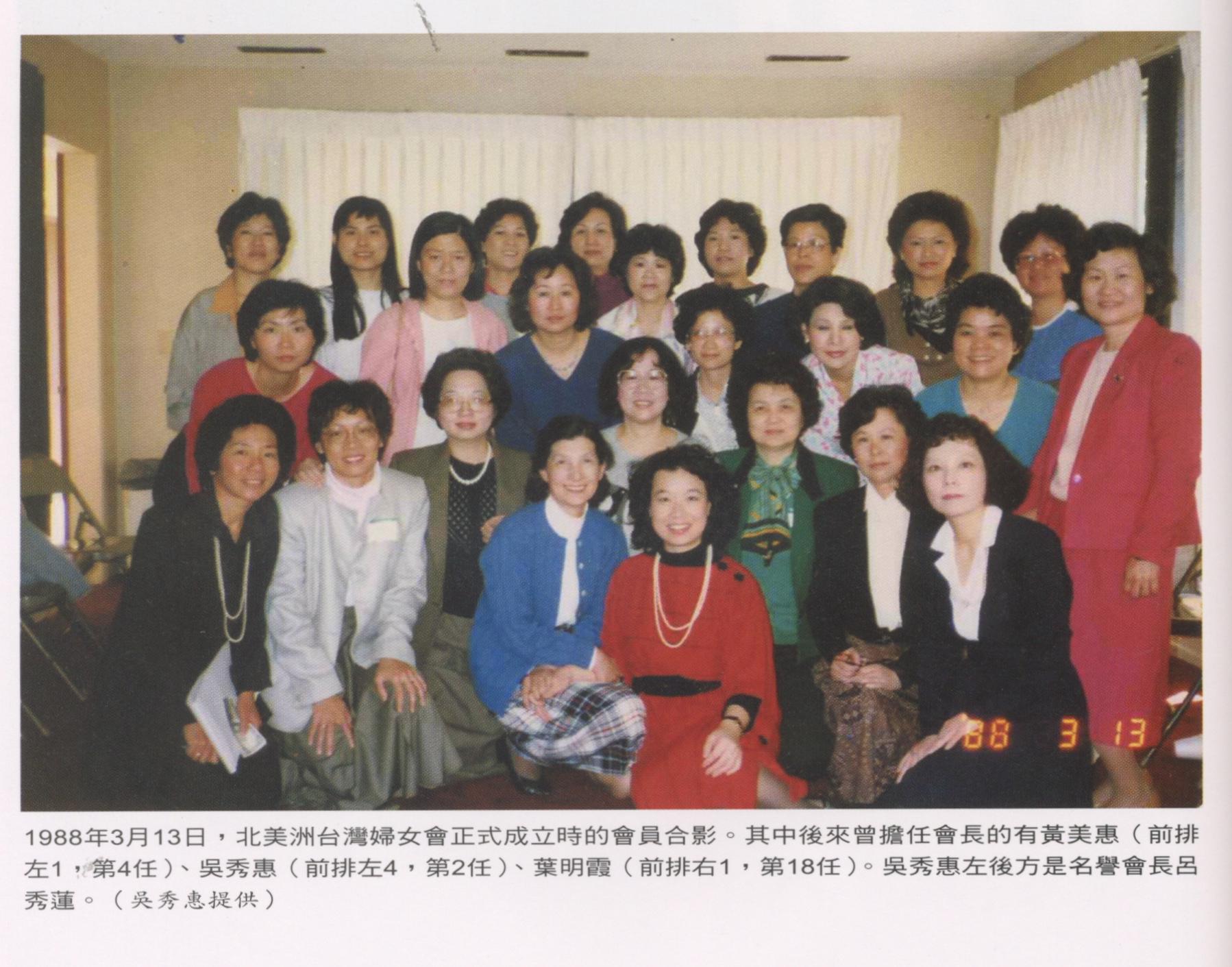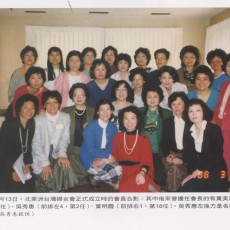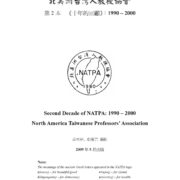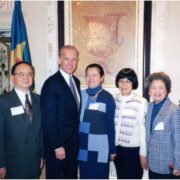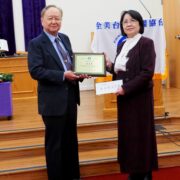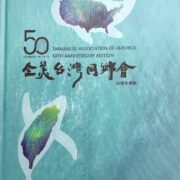History of the North America Taiwanese Women’s Association (NATWA)
Authors: Grace Wu Chou, Elena M. Ling
Established in March of 1988, NATWA is a newcomer amongst the overseas Taiwanese associations. The Association is younger than the Taiwanese Association of America (TAA), the World Federation of Taiwanese Associations (WFTA), the Formosan Association for Public Affairs (FAPA), the North America Taiwanese Professors’ Association (NATPA), and the North American Taiwanese Medical Association (NATMA). However, thanks to the leadership of previous presidents and the teamwork of the members, it has grown into incredible force that cannot be ignored. It is probably wise to look back on NATWA’s history and use it as reference as we move forward.
In the 80s, overseas Taiwanese associations were almost all male-dominated, while women were all doing work silently behind-the-scenes. At that time, women’s organizations were either affiliated with a church or a Taiwanese association. In 1987, the Taiwanese Association of American elected its first female president. President Maysing Huang wanted to add a women’s department to the Taiwanese Association of America. At that time, Annette Lu, who had been imprisoned for many years in relation to the Formosa Incident, had been able to contact Amnesty International via overseas Taiwanese people. They worked hard to rescue her, and she was able to come to the United States on medical release. President Huang invited this neo-feminist pioneer to come lead the preparations for the new department, and she asked secretary Chiu-chih Yang to assist her. In March 1988, the Taiwanese Association of America held its annual meeting in Los Angeles. A group of over thirty women from different cities around North America met in another part of the TAA conference venue to explore the feasibility of adding a women’s department to the Taiwanese Association of America.
Under Annette Lu’s leadership and two days of constructive discussions, the vast majority of them women didn’t approve of the Women’s Association being affiliated with any other organization. They believed that North America needed to have an independent and autonomous organization for women. Thus, NATWA was formally established on March 13th, 1988. After completing preliminary discussions about NATWA’s organizational structure, Fu-Mei Chang was elected as the first President, Grace Wu Chou as Vice-president and the second-term President, and Annette Lu was invited to serve as Honorary President. During this meeting. Seven members were selected to work with the President and Vice-president to draft and complete the organization charter. On July 1988, all 45 members took a vote, passing the founding charter. The members who drafted the original charter stayed on as Directors for the first term, divided into seven regions: the East Coast, the West Coast, the South, the Great Plains, the Southeast, the Midwest, and Canada. The Director’s terms are two years each, and the President and Vice-President’s terms are one year each. However, the Directors from Southeast, Midwest, and Canada served for just one year during the first term. Afterwards, they re-elected three or four new Directors and the Vice-president every year. The biggest difference that NATWA has from other Taiwanese associations is that the elected Vice-president becomes the next President. The Vice-president assists the President in handling association affairs, and thus they are the ideal candidate to take over as President the following year.
After establishing the charter, the next six years were spent doing foundational work, such as: working to host programs at various summer conferences, promoting NATWA, recruiting members, designing a logo, publishing a member directory and newsletter, promoting friendship between members, registering NATWA as a company, applying to be a 501(c)(3) non-profit organization to facilitate tax-exemption benefits for donors, and encouraging and assisting the establishment of local NATWA chapters. Sixth President Li-Ying Lee applied her experience from leading American organizations to set up posts in various departments and institutionalizing NATWA by clearly documenting the responsibilities of each group leader, chapter President, Director, President, and Vice President. During the fourth annual meeting, she also saw that when President Elena M. Ling introduced leadership training lectures, it garnered a great response. Thus, we created the Mid-year Board Meeting in October to discuss the association’s affairs and host leadership trainings.
If an organization wants to grow bigger, it needs strong financial resources. NATWA’s financial situation is much better than a lot of other organizations, since women are naturally born with the virtue of being frugal. Additionally, NATWA’s workers give their time and effort without receiving anything in return. However, one of the biggest reasons that our finances are good is that NATWA prints a monthly calendar, and the donations received from this have become a fixed annual income for the association. Thus, we must mention the story of the monthly calendar.
In March 1990, Grace Wu Chou invited Mr. Rung-chu Kuo and Annette Lu to attend the annual meeting. Annette Lu is very involved with NATWA, which she took part in giving birth to, so she suggested to successive President, Dorothy M. Hung, that they create a monthly calendar to introduce Taiwan’s history, geography, and culture. They could clearly write the dates of important anniversaries of events in the promotion Taiwan’s democracy and independence in both Hanji and English. Additionally, she suggested that they mobilize the members to collect the contact information for their international friends, especially the information of U.S. and Canadian congressmen, so that they could gift the annual “Taiwanese Monthly Calendar” to their international friends and use this opportunity to promote national diplomacy. Dorothy M. Hung worked together with Vice-president Elena M. Ling, Grace Wu Chou, and Annette Lu to propose this idea to Mr. Rung-chu Kuo. They used the $10,000 generously donated by Mr. Kuo, nicknamed “Santa Claus,” as seed money for the project. NATWA’s first monthly calendar was released in November 1990. The first-ever 1991 calendar was themed “The Beauty of Traditional Taiwanese Architecture,” and its overall planning was done by Vivian Y. G. Fu. Vivian continued to be in charge of the project until she was elected as Vice-president in 1996, after which Y. J. Susan Chang took over. Mr. Rung-chu Kuo departed from this world in 1988, but his contribution to NATWA will never be forgotten. Mr. Kuo’s wife, Mrs. Shie Sun was the fourth-term Honorary President and is a permanent member of NATWA.
If the monthly calendar laid the economic foundations of NATWA, then the “Women’s Mailbox” helped NATWA gain popularity. “Women’s Mailbox” formally appeared in the Taiwan Tribune on March 25th, 1991. It was written by Mei Fun Tsai under the pen name A-hsiang. It was published once a week, later changing to twice a week. Nine months later, the Independence Weekly Post also began publishing it. The main purpose of the column was to help overseas Taiwanese resolve their emotional distress and miscellaneous life difficulties. It was very well received, and it can be said that the column brought a gentler and more relaxed quality to the more serious publication. Two years later, A-hsiang began suffering eye problems from overworking, so she let go of this burden and a number of different people, like Lanny T. Chen took over for her. During her time in office, President Li-Ying Lee commissioned A-hsiang to compile two years’ worth of articles and print them in a book. This book was published in June 1993. Women’s Mailbox continued to run until it ended in 2001. It was replaced by “Snack Bar,” which continues to allow Taiwanese community members to express their thoughts and experiences.
Abiding by its own mission, NATWA is collectively commits itself to selfless dedication, sisterhood, and team spirit, and thus, NATWA’s development has far exceeded expectations. After each President takes over, she maintains the spirit of inheriting the past and ushering in the future, working hard to bring NATWA to an even better place. For example, Gin-Ru Lee established a funding system and openly discussed “Women and Sexuality.” Su-chiu Li was the first to invite American speakers to host a discussion about “EQ.” Vivian Y. G. Fu established the “Fund Raising Committee,” the “Fund Committee,” and a speaker bureau with the hopes of bringing the brilliant speeches from the annual meetings to each different location. She also created an association anthem. Mei Fun Tsai passed regulations for the elections of the President, Vice-president, and Regional Directors. She also set up a “Scholarship Committee” to issue NATWA scholarships. Lanny T. Chen created the NATWA website and promoted local chapters’ community service activities. Jean Fang began issuing this newsletter and created a “Networking Committee.” Ingrid Liu established the “921 Earthquake Adopt-a-Child Planning Committee” and made very beautiful and generous NATWA bags. Y. J. Susan Chang joined with women from around the world to establish the Federation of Oversea Taiwanese Women’s Associations (FOTWA). Amy Chen made NATWA scarves and organized the first trip of NATWA women to engage in grassroots diplomacy at Capitol Hill. Nora Tsay started “Team Taiwan” and “NATWA II.” Mei-Li Yang set up the NATWA web membership directory and organized for a delegation to go to Geneva to join other Taiwanese organizations from around the world in petitioning for Taiwan to be allowed to join the World Health Organization. Cecelia Tsai brought NATWA II to life, creating the NATWA II internship and scheduling NATWA II programs at the annual meeting. For the first time, over 20 women of the 1.5 and 2nd generations participated in the meeting and were very successful in forming cross-generational friendships and reaching mutual understanding.
In 2005, Hurricane Katrina affected many NATWA members in New Orleans, and everyone donated generously, as if helping their own families. President Cecelia Tsai even made a special visit, demonstrating warm and touching sisterhood.
Fifth President Helen Wang broke through the blacklist, forming a group to return to Taiwan for a visit. At the annual meeting, she held an open forum called “Women and Politics,” making a breakthrough in the tradition of women not involving themselves in politics. Later, Li-Ying Lee also led a group back to Taiwan to participate and assist with the Global Summit of Women in February 1992. In August 2000, Ingrid Liu and the Peng Wan-Ru Foundation worked together to hold the Taiwan-US Forum.” Y. J. Susan hosted the FOTWA annual meeting twice at the WFTA Conference. In September 2003, Nora Tsay led five representative members back to Taiwan to participate in the Democratic Pacific Assembly organized by Vice-president Annette Lu. During the 2000 and 2004 Presidential elections, Jean Fang and Nora Tsay took delegations back to Taiwan to actively participate in election campaigns. In December 2000, the World Taiwanese Congress (WTC) was established, and NATWA was selected as a permanent member, which has been the greatest acknowledgement of NATWA by the overseas Taiwanese community.
Over the last 18 years, NATWA has grown immensely, going from just over 40 members at its establishment, to over 1,000 members currently, which includes hundreds of staff. Looking back over NATWA’s history, it can be said that through this organization, North America’s Taiwanese women have been able to build an identity and consciousness, support and encourage one another, and grow together. Over the last 18 years, NATWA has also nurtured the growth of many leaders, making unique contributions to both North American and Taiwanese societies.
Stella Chen Landauer had a saying: “to educate a man is to educate one person, but to educate a woman is to educate an entire family.” When NATWA was first established, she encouraged members of the “Women’s Movement for Democracy in Taiwan,” which she established, to join NATWA, and she herself was a member. She broke through the blacklist, and though she passed away of an illness in Taiwan in mid-August of 1988, her wisdom and courage will forever be held up as a model for NATWA members.
Sourced from NATWA Magazine 07/2006
Translated from 60. 咱的故事—NATWA的歷史 / 吳秀惠、黃美惠合寫/2014/11

